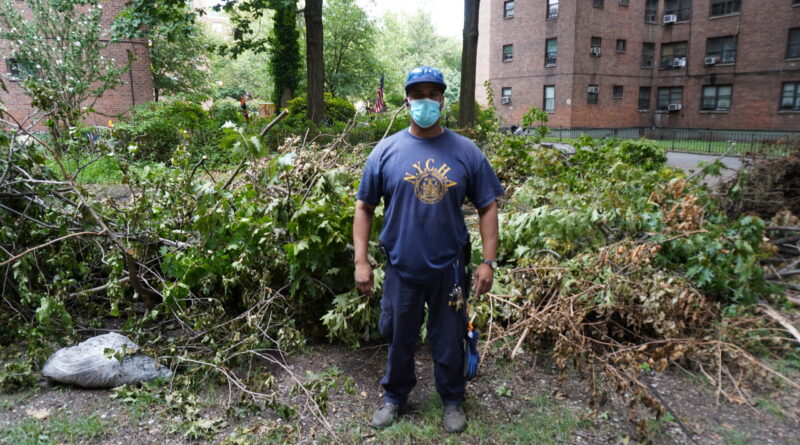NYCHA’s Response to Tropical Storm Isaias
Three days after Tropical Storm Isaias made landfall in New York City, NYCHA’s Office of Emergency Management Director Rudy Murillo inspected the damage at Cooper Park Houses and Marcy Houses in Brooklyn. Considering the impacts throughout NYC, the damage was minimal, thanks to prudent measures such as addressing trees with the potential to injure residents before the storm and using grounds crews to gather loose branches after the storm had passed.
“When I went to do my rounds at 2 p.m. the day after the storm, it was like nothing had even happened,” said Fia Cook, the Property Maintenance Supervisor at Cooper Park Houses.
With hurricane season underway, NYCHA Now spoke with Emergency Management Director Rudy Murillo; Emergency Services Department Director Erenisse Tavarez; and Vice President of Public Housing Operations Joe Courtien on the shared challenges of storm response planning during COVID-19, how the departments work in tandem with each other, and the ways information is shared to coordinate any necessary response and repairs.
How did the challenges of social distancing change NYCHA’s approach to the planning and response effort for Tropical Storm Isaias?
When you can’t have an in-person Emergency Operations Center (EOC), which is basically the command center for responding to emergencies, you have to re-analyze and adapt. What we realized is that if the EOC can theoretically be set up anywhere, then why couldn’t it be set up virtually? It’s important to have the right technology in place beforehand. Because of COVID-19, NYCHA staff serving as EOC representatives were already becoming accustomed to working remotely and using collaborative software like Microsoft Teams.
Can you describe how NYCHA coordinates with different departments internally during an event like this?
Our role is to coordinate, to make sure that the right people are talking to each other and the right things are in place so when someone needs something, they can get it. For example, if the Operations Department needs a generator, we can go to the Emergency Services Department and make the request. Other departments, like Procurement, assist us in supporting response efforts by securing additional vendors to handle tree removal if needed. If our internal departments cannot support for whatever reason, we will escalate to request NYC resources. It’s being the person to put someone in touch with someone else so that there isn’t any duplication of effort and you aren’t losing time.
Can you talk about what it was like to prepare for Tropical Storm Isaias in real time?
The forecast we got on the Friday before the storm was that New York City was going to receive six to eight inches of rain. What we actually got was one to three inches of rain. Unfortunately, you have to prepare for whatever may happen. If it’s heavy rain, you might have to make sure that development staff put up sandbags and close roof doors to make sure water doesn’t get into the elevator shaft. If it’s high winds like we experienced, you have to talk to the Capital Projects team to make sure that the sidewalk sheds and any loose debris from construction sites are secured so they won’t cause a potential hazard. It is also important to have vendors on alert who are ready to come in the next day to handle any number of operational needs, be it draining backed-up sewage lines, removing hanging tree limbs, repairing damaged roofing, or reopening walkways for our residents. In that case we might coordinate between property managers and the Procurement Department to make sure emergency purchase orders for additional contractors are expedited. Because the plan we put in place for Tropical Storm Isaias accounted for heavy winds in addition to heavy rain, we were already prepared for these wide-ranging scenarios.
What are the communication tools you rely on to get information and direct resources during a fast-moving event like this?
When the EOC is activated, it is designed to have that information funnel up to everyone in the room. While property managers are calling their borough managers to get information to us, we’re also working with Emergency Services and monitoring the call volume for Customer Contact Center complaints, because we want to see if there’s been a huge uptick for a certain area that requires a specific response or attention.
What are you most proud of regarding how NYCHA dealt with Tropical Storm Isaias?
We were able to quickly bring all the key departmental leaders (Emergency Services, Operations, etc.) together on a conference call right after being briefed by the City the Friday before the storm. Providing a way for all of us to share what we need and what our concerns are speaks to the level of coordination that we’ve been able to increase.
Photo caption: Marcy Houses’ Supervising Groundskeeper Anthony McLeod in front of some of the branches he helped gather after the storm.







